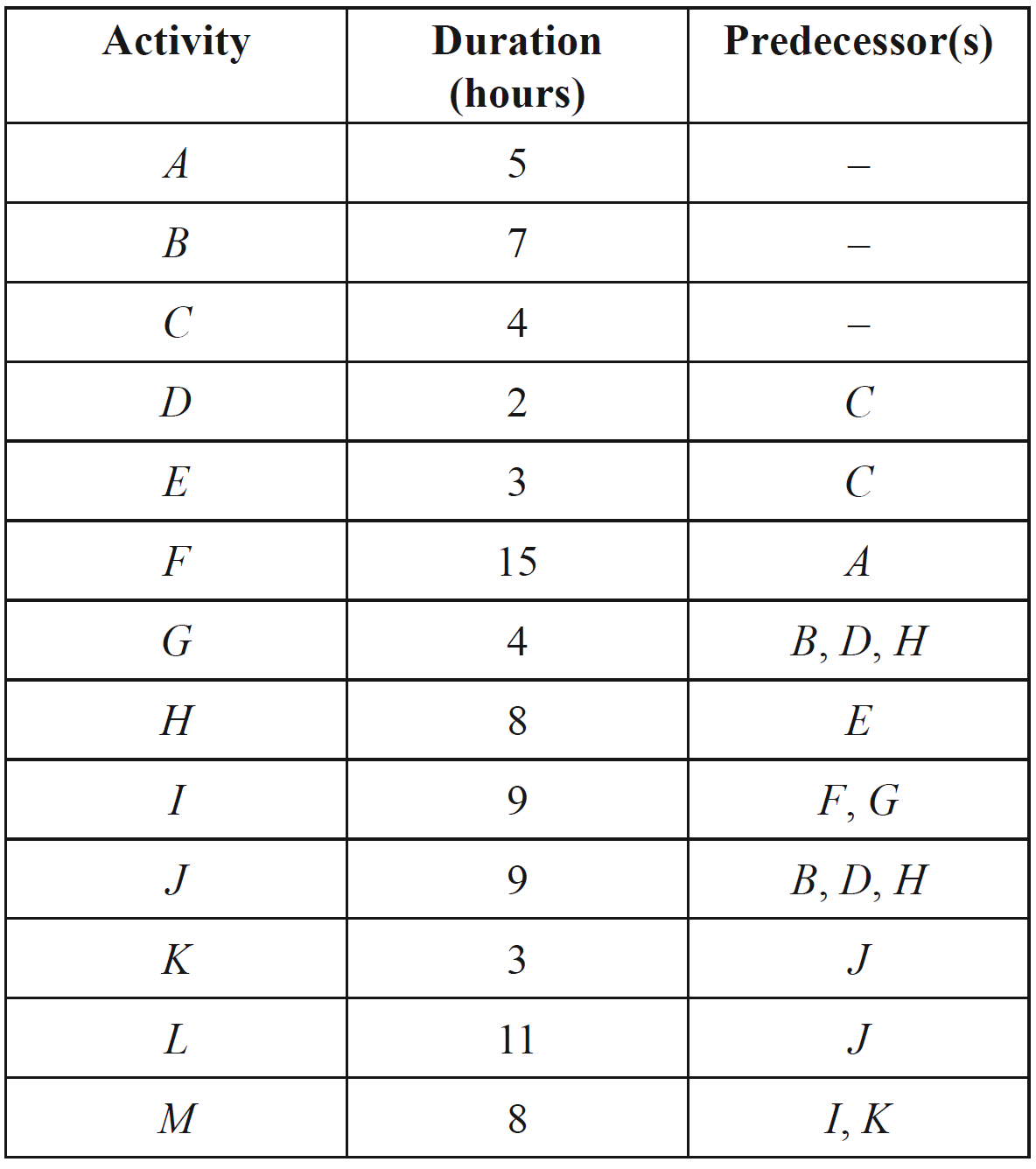One of the landmarks in state \(A\) requires a renovation project.
This project involves 12 activities, \(A\) to \(L\). The directed network below shows these activities and their completion times, in days.
The table below shows the 12 activities that need to be completed for the renovation project.
It also shows the earliest start time (EST), the duration, and the immediate predecessors for the activities.
The immediate predecessor(s) for activity \(I\) and the EST for activity \(J\) are missing.
\begin{array} {|c|c|c|}
\hline
\quad \textbf{Activity} \quad & \quad\quad\textbf{EST} \quad\quad& \quad\textbf{Duration}\quad & \textbf{Immediate} \\
& & & \textbf{predecessor(s)} \\
\hline
\rule{0pt}{2.5ex} A \rule[-1ex]{0pt}{0pt} & 0 & 6 & - \\
\hline
\rule{0pt}{2.5ex} B \rule[-1ex]{0pt}{0pt} & 0 & 4 & - \\
\hline
\rule{0pt}{2.5ex} C \rule[-1ex]{0pt}{0pt} & 6 & 7 & A \\
\hline
\rule{0pt}{2.5ex} D \rule[-1ex]{0pt}{0pt} & 4 & 5 & B \\
\hline
\rule{0pt}{2.5ex} E \rule[-1ex]{0pt}{0pt} & 4 & 10 & B \\
\hline
\rule{0pt}{2.5ex} F \rule[-1ex]{0pt}{0pt} & 13 & 4 & C \\
\hline
\rule{0pt}{2.5ex} G \rule[-1ex]{0pt}{0pt} & 9 & 3 & D \\
\hline
\rule{0pt}{2.5ex} H \rule[-1ex]{0pt}{0pt} & 9 & 7 & D \\
\hline
\rule{0pt}{2.5ex} I \rule[-1ex]{0pt}{0pt} & 13 & 6 & - \\
\hline
\rule{0pt}{2.5ex} J \rule[-1ex]{0pt}{0pt} & - & 6 & E, H \\
\hline
\rule{0pt}{2.5ex} K \rule[-1ex]{0pt}{0pt} & 19 & 4 & F, I \\
\hline
\rule{0pt}{2.5ex} L \rule[-1ex]{0pt}{0pt} & 23 & 1 & J, K \\
\hline
\end{array}
- Write down the immediate predecessor(s) for activity \(I\). (1 mark)
--- 1 WORK AREA LINES (style=lined) ---
- What is the earliest start time, in days, for activity \(J\) ? (1 mark)
--- 1 WORK AREA LINES (style=lined) ---
- How many activities have a float time of zero? (1 mark)
--- 1 WORK AREA LINES (style=lined) ---
The managers of the project are able to reduce the time, in days, of six activities.
These reductions will result in an increase in the cost of completing the activity.
The maximum decrease in time of any activity is two days.
\begin{array} {|l|c|}
\hline
\rule{0pt}{2.5ex} \textbf{Activity} \rule[-1ex]{0pt}{0pt} & \quad A \quad & \quad B \quad& \quad F \quad & \quad H \quad & \quad I \quad & \quad K \quad \\
\hline
\rule{0pt}{2.5ex} \textbf{Daily cost (\$)} \rule[-1ex]{0pt}{0pt} & 1500 & 2000 & 2500 & 1000 & 1500 & 3000 \\
\hline
\end{array}
- If activities \(A\) and \(B\) have their completion time reduced by two days each, the overall completion time of the project will be reduced.
- What will be the maximum reduction time, in days? (1 mark)
--- 2 WORK AREA LINES (style=lined) ---
- The managers of the project have a maximum budget of $15 000 to reduce the time for several activities to produce the maximum reduction in the project's overall completion time.
- Complete the table below, showing the reductions in individual activity completion times that would achieve the earliest completion time within the $ 15 000 budget. (1 mark)
--- 0 WORK AREA LINES (style=lined) ---
\begin{array} {|c|c|}
\hline
\quad\textbf{Activity} \quad & \textbf{Reduction in completion time} \\
& \textbf{(0, 1 or 2 days)}\\
\hline
\rule{0pt}{2.5ex} A \rule[-1ex]{0pt}{0pt} & \\
\hline
\rule{0pt}{2.5ex} B \rule[-1ex]{0pt}{0pt} & \\
\hline
\rule{0pt}{2.5ex} F \rule[-1ex]{0pt}{0pt} & \\
\hline
\rule{0pt}{2.5ex} H \rule[-1ex]{0pt}{0pt} & \\
\hline
\rule{0pt}{2.5ex} I \rule[-1ex]{0pt}{0pt} & \\
\hline
\rule{0pt}{2.5ex} K \rule[-1ex]{0pt}{0pt} & \\
\hline
\end{array}
















